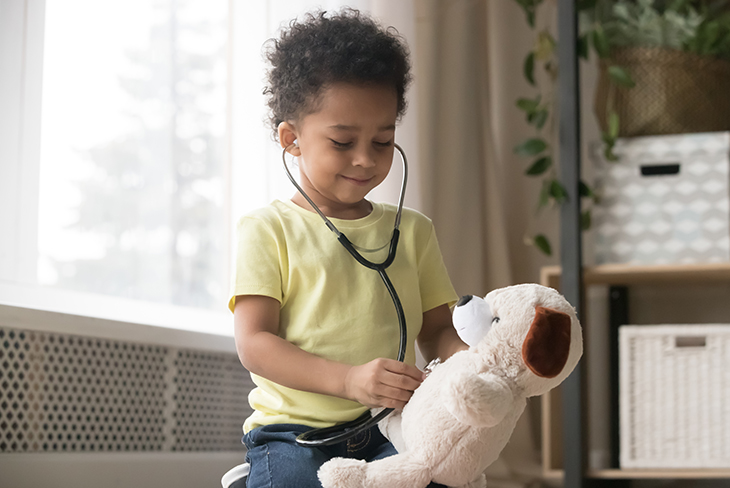First aid for children during summer

Summer can be a hazardous time for babies, who risk getting sunburn, being stung by a flying critter or insect bites. Paediatrician Dr Natasha Padayachee-Govender from Life Fourways Hospital in Johannesburg offers expert advice about first aid for children.
When a rash appears
‘Most children experience a rash at one time or another, and many [rashes] disappear without treatment. Others may be accompanied by fever, itchiness and other symptoms,’ says Dr Padayachee-Govender.
Heat rash
‘Heat rash, or prickly heat, might appear if your baby gets hot in a humid environment,’ says Dr Padayachee-Govender. ‘The rash shows as tiny red bumps or blisters on the skin, which can be very itchy. Cooling your baby down and avoiding humidity is the best way to counteract heat rash, which usually clears within two to three days without treatment.’
Hives
‘Another rash to look out for is urticaria, also known as hives. This is an outbreak of swollen, pale red bumps or plaques (wheals) on the skin that appear suddenly, either as a result of the body’s reaction to certain allergens, or for unknown reasons. Hives usually cause itching, but may also burn or sting,’ says Dr Padayachee-Govender. If the rash doesn’t go away, seek medical assistance.
Molluscum contagiosum
‘A rash that may crop up in summer with increased skin-to-skin contact or by sharing swimming pool water or towels is Molluscum contagiosum,’ says Dr Padayachee-Govender.
‘Molluscum contagiosum spots look like pimples and grow into round pearly white lumps, usually 2–5mm in size. They can be itchy. Usually they heal without treatment within six months, but it might take longer.’
‘Whatever their age, take your child to the doctor if they have a rash and feel unwell, with a persistent high temperature or cold, or persistent cough symptoms, or swollen neck glands.’
Signs of dehydration
‘Dehydration remains a major cause of morbidity and mortality in infants and young children worldwide,’ says Dr Padayachee. ‘Dehydration in infants or children results from a loss of fluid volume (due to diarrhoea or vomiting) or due to decreases in fluid.’
Mild dehydration
Mild dehydration symptoms include a slightly dry mouth and thirst. ‘Children who are mildly dehydrated do not need immediate medical attention, but should be given extra fluids and monitored for signs of worsening dehydration,’ says Dr Padayachee-Govender.
Moderate or severe dehydration
Signs of moderate or severe dehydration include:
- Decreased urination (not going to the bathroom or no wet nappy in six hours)
- A lack of tears when crying
- A dry mouth
- Sunken eyes
- Cool or clammy hands and feet
- Listlessness
A child who is moderately or severely dehydrated should be evaluated by a doctor or nurse as soon as possible.
When a bee stings
‘Being stung by a bee, wasp, hornet or yellow jacket can be both painful and scary,’ says Dr Padayachee-Govender. ‘Some children may have serious or even life-threatening reactions to stings, which require quick treatment.
1. Remove the stinger
‘After being stung, you should remove the stinger from your child’s skin as soon as possible to prevent any more venom from being released. Use the back of a bank or store card or a blade to scrape out the stinger – be careful to avoid pinching the poison sac at the end, which could introduce more venom into the body.
‘Most children who are stung by an insect will develop a local reaction (an area of swelling and redness). Some children may also develop a severe allergic reaction called anaphylaxis.
2. Treat immediately
To soothe baby’s immediate discomfort, wrap ice in a cloth and apply to the site of the sting to reduce swelling. Then apply calamine lotion to soothe itching, advises the Little Life newborn guide (Your Baby).
3. Look for allergy symptoms
‘Symptoms of an allergic reaction usually develop quickly and include skin symptoms, such as hives, redness or swelling of skin away from the area that was stung, belly cramps, nausea, vomiting or diarrhoea, hoarse voice, shortness of breath and difficulty breathing,’ says Dr Padayachee-Govender.
Severe allergic reactions are a medical emergency that can be fatal if not treated quickly. If your baby develops any symptoms of anaphylaxis, you need to get him to emergency care as soon as possible. If your slightly older child (>15kg) has already been diagnosed as having a potentially serious allergy, make sure you have an adrenaline auto-injector (Epipen) readily available.
When the sun burns
‘There are a number of effective ways to prevent sunburn, including staying out of the sun during peak hours, sunscreen and protective clothing,’ says Dr Padayachee-Govender. ‘While these measures are important for everyone, they are especially important for children and people with fair skin, who burn easily and tan poorly.’
If your baby’s skin is red and swollen, and he or she is crying after spending a day out in the sun, chances are they’ve been sunburnt.
Treatment
Cool the skin with a cool bath, apply cool water compresses and use a water-based moisturiser or an aloe-based skin gel, advises the Little Life newborn guide (Your Baby).
‘Give your child paracetamol or ibuprofen for discomfort and fever. Be sure to follow the directions on the container and never use aspirin in children,’ says Dr Padayachee-Govender.
‘Apply a plain topical moisturiser, aloe or burn gel, or a topical pain reliever to mildly sunburnt skin. If blisters are present, don't break them open, as infection can occur, and rather get a medical opinion.
‘Keep your child out of the sun until the burn is healed and give them extra fluid for several days to prevent dehydration.’
The information is shared on condition that readers will make their own determination, including seeking advice from a healthcare professional. E&OE. Life Healthcare Group Ltd does not accept any responsibility for any loss or damage suffered by the reader as a result of the information provided.

